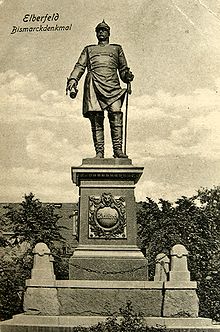Bismarck Monument (Elberfeld)
The Bismarck monument in the then independent town of Elberfeld (now part of Wuppertal ) was inaugurated in 1898 and has not been preserved.
The willingness to donate a Bismarck memorial was so great among the Elberfeld population that after a public appeal in February 1895, more than 60,000 marks were collected within a few weeks . Otto von Bismarck had run for the constituency Barmen-Elberfeld as a representative of the conservatives for the North German Reichstag in 1867 . He was elected in February 1867 in two ballots with 37.4% and 59.3% of all votes. Since the majority of the votes had only been achieved in the runoff election, Bismarck rejected this mandate and opted for his ancestral constituency Jerichow, Magdeburg district. In this constituency, he had won an absolute majority in the first round of elections.
The middle classes in Elberfeld had obviously forgiven him after three decades. On March 11, 1895, Otto von Bismarck was granted honorary citizenship of the city of Elberfeld in a secret meeting of city councilors . This decision was passed with 19 votes to 11, seven votes against came from the ranks of the Liberals and four votes from the Center Party .
On April 1, 1895, the 80th birthday of the founder of the empire, Bismarck, the monument committee published the final decision on the erection of the monument. In a greeting, which is said to have been a masterpiece of calligraphy , the prince was announced that a monument was to be erected in his honor. The design by the Berlin sculptor Ludwig Brunow emerged victorious from a subsequent limited competition among eight artists . In particular, the most convincing portrait truth and the unsurpassedly successful, lively movement of the right arm with the founding of the empire were praised, which give the figure an inner soul . In his statue of Bismarck, Brunow attached importance to an imperial gesture ; the index finger of the right hand, which is holding the document of the foundation of the Reich, is demonstratively placed on the front part. The 3.50 meter high bronze figure was cast in November 1897 in the renowned Schäffer & Walcker foundry in Berlin. The figure stood on a pedestal made of red polished granite, which the Berlin stonemason workshop Kessel & Röhl had supplied. On the sides of the pedestal, a bronze plaque was attached to each side. On the right and left were Bismarck's words:
" We Germans fear God, but nothing else in the world "
" I have dedicated my life to the unity, independence and freedom of Germany "
The front bronze plaque was labeled "Bismarck" and the back plaque contained Bismarck's coat of arms. The total height of the monument was 6.80 meters. It was the largest Bismarck monument to date.
The monument was erected on the corner of Mäuerchen / Schlossbleiche, directly on the banks of the Wupper in downtown Elberfeld ( 51 ° 15 ′ 21.3 ″ N , 7 ° 8 ′ 40.7 ″ E, ). In 1909 the representative building of the Sparkasse was built behind the monument. Associated with this was also a change in the base by removing the side pillars with the iron chains.
The memorial was inaugurated on March 31, 1898, the day before Bismarck's 83rd birthday, at 11 a.m. A large number of people attended the ceremony; around 3,000 places were reserved for donors of the monument on an area of 1050 m². Seat cards have been issued for these guests beforehand.
The historical report shows the public status that was attached to this monument:
“ So this monument, the most outstanding and largest of the numerous statues that the German people have erected for Prince Bismarck so far, becomes the awe-inspiring and dear figure of the man who, for our salvation, created so great and glorious, in an artistically perfect image Put the viewer in front of their eyes. It should make us, our children and grandchildren aware again and again that we owe the restoration of the German Empire, next to our beloved, unforgettable great Kaiser Wilhelm the First, Prince Bismarck. Even in the distant future, the sight of the man who has struggled all his life for German power and greatness will be a reminder to devote himself to the fatherland, to faithfully cling to the emperor and empire. "
Bismarck himself politely thanked him for the honor in a telegram from far-off Friedrichsruh . Like Kaiser Wilhelm I, it was uncomfortable for him to be honored with monuments during his lifetime, but unlike the Kaiser, he could not defend himself against it.
The monument was destroyed in World War II in 1943 (melted down for armaments purposes, according to other sources). The city center was built on the former site in the 1980s.
Individual evidence
- ↑ a b Wuppertal City Archives , inventory C III / 96
literature
- Festschrift for the consecration of the Bismarck monument in Elberfeld. ( Wuppertal City Archives )
- Ruth Meyer-Kahrweg : Monuments, fountains and sculptures in Wuppertal . Born-Verlag, Wuppertal 1991, ISBN 3-87093-057-8 .
- Sieglinde Seele : Lexicon of the Bismarck Monuments . Michael Imhof Verlag, Petersberg 2005, ISBN 3-86568-019-4 .
